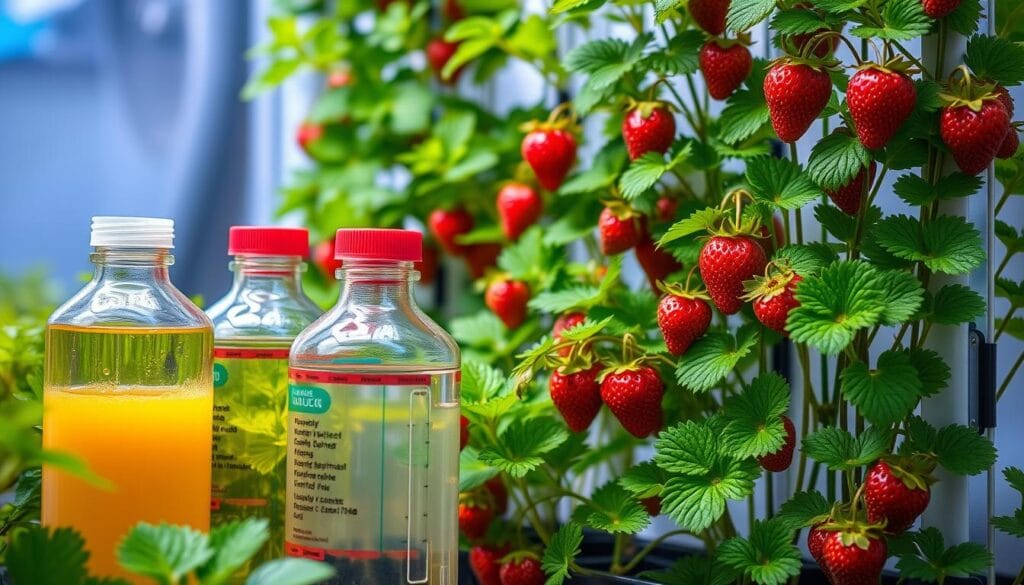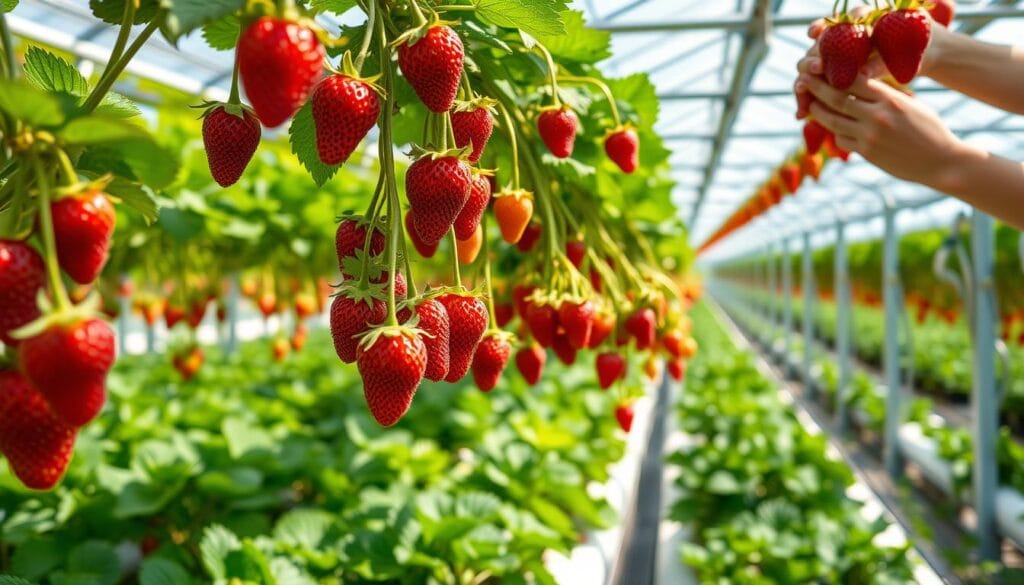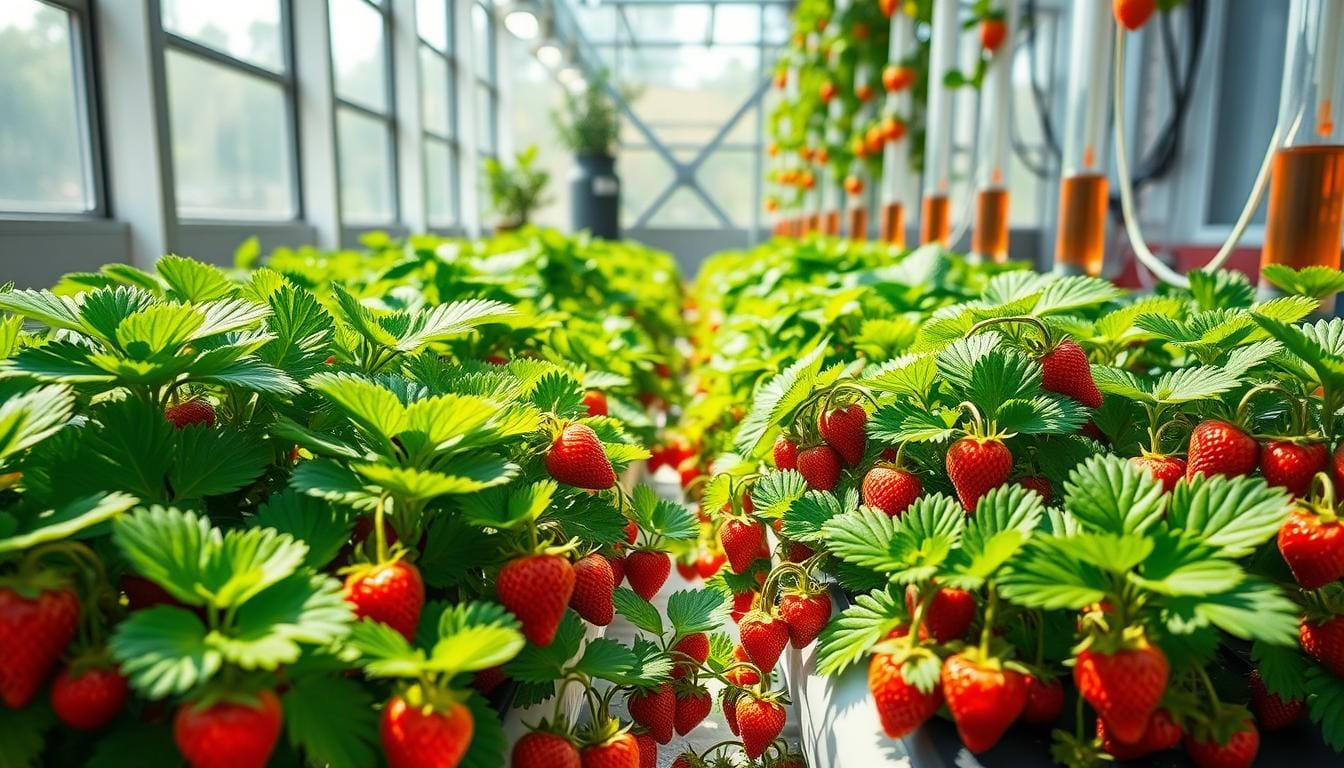More people are looking for fresh, local food In today’s world. If you’re interested in growing your own delicious, healthy strawberries, learning how to grow hydroponic strawberries is an excellent option. Hydroponic gardening is a great way to grow strawberries indoors or in smaller spaces. It’s rewarding to pick juicy strawberries from your home, and with hydroponics, you can enjoy fresh fruit all year round.
Hydroponic gardening is perfect for those with little outdoor space. It’s also great for taking your gardening to new levels.
Key Takeaways
- Hydroponic strawberry cultivation provides higher yields, faster growth, and year-round production.
- Hydroponic systems are suitable for small spaces and can be set up indoors, making them ideal for apartment dwellers or those without outdoor gardens.
- Proper nutrient management, temperature control, and light requirements are essential for successful hydroponic strawberry growth.
- Selecting the right strawberry varieties and implementing effective training techniques can maximize your yield.
- Proactive pest and disease management strategies are crucial for maintaining healthy hydroponic strawberry plants.
Understanding Hydroponic Strawberry Cultivation Basics
Hydroponic strawberry growing has many advantages over traditional soil methods. These systems can grow strawberries faster and more efficiently. They also allow for growing all year, perfect for small spaces.
Benefits of Growing Strawberries Hydroponically
- Increased yields and faster growth rates
- Year-round production potential
- Space-efficient vertical farming capabilities
- Reduced risk of soil-borne pests and diseases
- Significant water conservation through recirculation
- Consistent quality in size, color, and flavor
Key Components of a Hydroponic System
A hydroponic strawberry system needs a water reservoir, growing medium, nutrient solutions, and good lighting. Keeping these parts in check is key for healthy plants and fruit.
Essential Growing Conditions
Strawberries in hydroponics do best in 60-80°F (15-27°C) temperatures. They need 50-70% humidity to avoid mold. They also need 8-12 hours of light daily for growth.
Keeping the nutrient solution’s pH between 5.5-6.5 is vital. This ensures the plants absorb nutrients well.
Selecting the Right Strawberry Varieties for Hydroponics
Choosing the right strawberry varieties for hydroponics is key. Day-neutral and everbearing strawberries are top picks for this method.
Day-neutral strawberries, like ‘Albion’ and ‘Seascape’, keep producing fruit all season. They’re great for hydroponics because they don’t mind the controlled environment as much as other types.
Everbearing strawberries give you two to three harvests a year. ‘Mara des Bois’ and ‘Evie 2’ are perfect for hydroponics because they love the setup’s nutrient and water conditions.
Think about your climate and USDA growing zone when picking strawberries for hydroponics. The right choice means a steady supply of fresh strawberries all year, making your hydroponic setup worth it.
“Hydroponic gardening has gained popularity as a sustainable method, allowing for cleaner, pest-free strawberries with faster growth and higher yields compared to traditional soil cultivation.”
- Compact or trailing strawberry varieties are suitable for hydroponic systems, as they can be easily trained and supported.
- Nutrient solution for hydroponic strawberries should contain essential elements like nitrogen, phosphorus, and potassium.
- Maintaining consistent moisture levels is crucial for the optimal growth of hydroponic strawberries.
How to Grow Hydroponic Strawberries
Growing strawberries hydroponically has many benefits. It saves water and lets you grow them all year. First, you need to set up your system right. This includes managing nutrients and plant support.
Setting Up Your Growing System
Pick a hydroponic method that fits your space and budget. Options include the wick system, water culture, or ebb and flow. Make sure your system supports your plants well and has good airflow.
Nutrient Solution Preparation
Make a nutrient solution that strawberries need. Keep the pH between 5.5 and 6.5. The electrical conductivity (EC) should be 1.0 dS/m or less. Add important minerals like nitrogen, potassium, calcium, and magnesium for growth and fruit.
Plant Support and Training
Use strong trellises or vertical systems to support your plants. This saves space. Prune and train the plants to grow well and efficiently.
By following these steps, you can set up a thriving hydroponic strawberry garden that delivers a bountiful harvest all year round.
“Hydroponic systems can cut water usage by as much as 90% compared to conventional soil-based methods.”
Essential Equipment and Materials Needed
Starting a hydroponic strawberry garden needs the right tools and materials. From growing containers to nutrient solutions, each part is key for a good harvest. Here’s what you’ll need to begin:
- Hydroponic Containers or Trays: These containers must be safe for food and water-resistant. They should let the roots grow and drain well.
- Growing Medium: Strawberries do well in perlite, coconut coir, or a mix. These help with air and water for the roots.
- Nutrient Solutions: A balanced nutrient mix is vital for hydroponic plants. Choose a high-quality hydroponic nutrient mix.
- pH and EC Meters: It’s important to check the pH and EC of the solution often. This keeps the plants growing well.
- Air Pumps and Aeration System: Good air for the roots is key for healthy plants. An air pump and air stones help with this.
- Lighting Systems: Strawberries need lots of light. LED grow lights are a good choice because they’re energy-efficient and adjustable.
Choose food-safe and water-resistant equipment and materials. Automated systems can make care easier for bigger gardens. With the right gear and a good setup, you’ll grow a healthy strawberry crop.
“Hydroponic systems can greatly reduce water usage compared to traditional soil-based methods, thanks to the continuous recycling and recirculation of nutrient solutions.”
Optimal Growing Environment Requirements
Creating the perfect growing space is key for hydroponic strawberries to thrive. You need to watch temperature, humidity, and light closely. This ensures a good harvest.
Temperature Control
Keep the temperature between 60-75°F (15-24°C) for best growth. If it gets too hot or cold, it can stress the plants and hurt fruit production.
Humidity Management
It’s important to balance humidity levels. Aim for 50-70% to avoid fungal problems and help plants grow well.
Light Requirements
Hydroponic strawberries need 8-12 hours of light a day. Use LED or fluorescent grow lights 6-12 inches above the plants. This ensures they get the right environmental factors for strong growth.
Keep an eye on these climate control factors. Adjust them based on the plant’s growth stage and type. This is how you get the most out of your hydroponic strawberry system.
“Precise environmental control is the foundation for bountiful hydroponic strawberry harvests. Growers who master temperature, humidity, and lighting will reap the rewards of luscious, flavorful berries year-round.”
Nutrient Management and Water Quality
To grow a lot of hydroponic strawberries, you need the right nutrients and clean water. Use nutrients made just for strawberries. These blends give your plants the nutrients they need to grow well and produce lots of fruit.
Keeping the pH right is key for growing strawberries in hydroponics. The best pH for them is between 5.5 and 6.5. This allows plants to absorb nutrients more efficiently and maintain better overall health. Check the pH often and adjust it if it’s not in this range.
Also, watch the electrical conductivity (EC) of your nutrient solution. It should be between 1.0 and 1.4 mS/cm. This ensures your plants get the nutrients they need without getting too much salt. Change the nutrient levels if you need to keep the EC in this range.
| Nutrient Parameter | Ideal Range |
|---|---|
| pH | 5.5 – 6.5 |
| Electrical Conductivity (EC) | 1.0 – 1.4 mS/cm |
Use clean water to avoid contamination and help your plants absorb nutrients better. The best water is filtered or treated with reverse osmosis (RO). This helps maintain a balanced nutrient solution, promoting healthy plant growth.

“Proper nutrient management and water quality are the foundation of a thriving hydroponic strawberry garden.”
Plant Care and Maintenance Schedule
Keeping your hydroponic strawberry garden healthy needs a regular care plan. It’s important to watch your system and take care of your plants every day. This supports healthy growth and encourages high fruit production. Here are the key tasks to do daily, Be sure to monitor for pests or diseases and address any issues promptly.
Daily Monitoring Tasks
Begin your day by checking your hydroponic garden closely. Look at the nutrient levels, pH, and how your plants are doing. Make sure the nutrient solution is right and the pH is between 5.5 and 6.5. Also, watch for pests or diseases and deal with them quickly.
Weekly Maintenance Requirements
Once a week, do some important maintenance. Start by cutting off any dead or damaged parts of your plants. This helps air move better and encourages growth. Additionally, assist with pollination by gently shaking or brushing the flowers. Lastly, change the nutrient solution to keep your plants healthy.
Monthly System Checks
Every month, do a deep clean and check of your system. Begin by cleaning and disinfecting everything, like the reservoir, tubing, and trays. Look for any buildup or problems with your equipment and fix them. Also, make sure your pH and EC meters are working right.
By sticking to this care and maintenance plan, your hydroponic strawberries will do great. They’ll give you lots of fruit all season long. Remember, being careful and adjusting your routine as needed is key to growing great strawberries in a hydroponic garden.
Common Challenges and Solutions
Starting a hydroponic strawberry garden has its ups and downs. But with the right steps, you can beat these challenges and get a great harvest. We’ll look at how to handle nutrient problems and keep your plants healthy.
Nutrient Imbalances
It’s key to keep the right balance of nutrients for your strawberries. Watch for signs like yellow leaves or slow growth. Check the pH of your solution often, keeping it between 5.5 and 6.5. Replace the solution every two weeks to avoid potential issues.
Pest and Disease Control
Hydroponic gardens can face pests and diseases. Look out for aphids, spider mites, and powdery mildew. Use a mix of physical barriers, beneficial bugs, and organic treatments to protect your plants.
Environmental Conditions
Strawberries need the right temperature, humidity, and light. Maintain the temperature between 60-80°F (15-27°C) and humidity levels between 50-70%. Give them 8 to 12 hours of good light each day.
By tackling these common problems, you can grow great hydroponic strawberries. Keep a close eye on your plants and their environment for success.
“Hydroponic systems allow for precision control over the growing environment, making it easier to identify and resolve issues that may arise, leading to healthier plants and better overall yields.”
Harvesting and Post-Harvest Handling
Timing is everything when it comes to picking your hydroponic strawberries. Wait until the fruits are fully ripe, with a consistent red color and a slight softness. To get the most berries, pick them every 2-3 days when they’re in season.
Be gentle when picking your strawberries. This helps avoid bruising or damaging the delicate fruits. After picking, it’s important to store them right to keep them fresh and tasty.
When to Harvest
- Look for strawberries with a deep, uniform red color and a slight softness to the touch.
- Harvest every 2-3 days during the peak production season to ensure the best quality.
- Treat the berries with care to avoid crushing or harming them.
Storage Guidelines
To keep your strawberries fresh, store them at 32°F (0°C) with 90-95% humidity. This cool, humid spot preserves their freshness. Enjoy or use your strawberries within 5-7 days for the best taste and texture.

“Proper post-harvest handling is essential for preserving the quality and extending the shelf life of hydroponic strawberries. By following these guidelines, you can ensure that your delicious berries are enjoyed at their best.”
Maximizing Yield Through Proper Training Techniques
Growing hydroponic strawberries is more than just giving them the right food and environment. You need to use effective training methods to get the best results. By using smart plant management, you can make your hydroponic strawberry system work its best.
One important step is to remove any runners that grow. This lets the plant focus on making lots of good fruit instead of growing more leaves. Also, trimming off old leaves helps air move better and lets more light in. This makes your plants grow more fruit.
- Support fruit clusters as they grow to keep them away from the nutrient solution. This keeps the fruit safe and helps it grow better.
- Use vertical growing like trellising or staking to grow more plants in the same space. This way, you can get more fruit from the same area.
Learning these training methods can make your hydroponic strawberry system very productive. You’ll get a big harvest and a more efficient growing space.
Disease Prevention and Pest Management
Keeping your hydroponic system healthy is key to a great strawberry harvest. It’s important to prevent diseases and manage pests well. Knowing the common problems and using the right solutions will help your strawberry plants grow strong.
Common Diseases
Root rot and botrytis are big problems for hydroponic strawberries. Root rot comes from fungi and can make leaves turn yellow and roots slimy. To stop it, make sure there’s good air flow and don’t water too much.
Botrytis, or gray mold, can quickly spread on plants, turning them brown. Keep the air moving and watch the humidity to fight botrytis.
Pest Control Methods
Hydroponic strawberries can attract pests like spider mites, aphids, whiteflies, and thrips. Spider mites are tiny and can be many colors. Aphids are small and can be a big problem. Whiteflies and thrips are also pests that can harm your plants.
To control these pests, use an integrated pest management (IPM) plan. Add beneficial insects like ladybugs or lacewings to eat the pests. Use organic pest control, like neem oil, to stop pests without harming your plants. Also, keep the air moving and don’t overwater to make your plants less appealing to pests.
By watching closely, taking preventive steps, and using good pest control, you can grow healthy hydroponic strawberries. Enjoy a big harvest from your hard work.
Conclusion
Hydroponic strawberry growing is a green and efficient way to produce food all year. By setting up your system right, taking care of your plants, and keeping things in order, you can get lots of tasty, chemical-free strawberries. This method is getting better, offering great chances for both home gardeners and big producers to grow strawberries well.
There are many good things about growing strawberries this way. You use less water, get more and better strawberries, don’t need as many chemicals, and can grow them almost anywhere. Varieties like Albion, San Andreas, Monterey, and Camino Real do great in these systems. They taste amazing, are firm, and fight off diseases well.
When you start growing strawberries hydroponically, aim to make your system better, manage your nutrients and water, and give your plants the best climate. With the right effort and care, you can make the most of this green and productive way to grow strawberries. This helps make our food system healthier and stronger.

